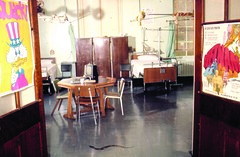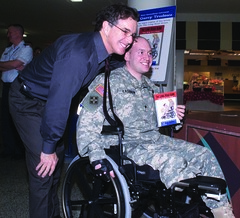Pictures from today's installation of the new Lincoln exhibit:
This one's not actually from today, but it shows our registrar with a drawer that slides in under the exhibit case which will hold a moisture-controlling substance.

Jim is placing an original drawing of Lincoln's death scene, by Hermann Faber.

The probe that doctors used to try to find the bullet in Lincoln's brain is being marked for position.

Now that the positions are marked and plexiglass posts are in place to hold everything where it needs to be, the panel is taken to the exhibit floor and placed on the stand. Jim and Steve fine-tune placement of documents.

The case's contents have been carefully laid into place and now Jim and Steve lower the plexi cover ve-e-e-ry gently and settle it down and around the platform.

The contents of the second case have been prepped by being backed with stiffening board and held in place with mylar strips. Some of the things on this table are an account by the first doctor to treat Lincoln, Charles A. Leale (coincidentally, this pamphlet was republished by Dr. Leale's estate on the 100th anniversary of Lincoln's birth), and a tear sheet from the Medical and Surgical History of the War of the Rebellion, which lists Lincoln as another casualty of the war. He is listed in the book as A____ L____.

The second case has been brought to the exhibit floor and more items have been added, including a lock of Lincoln's hair, fragments from his skull, a blood-stained cuff from a doctor who treated him, and the bullet that killed him.
Uh-oh, the cuff is in the wrong place. Jim is holding the envelope that held the cuff when it was donated to the museum as Andrea suggests the correct location for the cuff.

Jim removes Lincoln's life mask from the temporary storage cabinet to add to the 3rd cabinet. Sorry for the blur.

The case's platform is placed on the floor, the Lincoln mask (a life mask, not a death mask) is lowered onto batting, and we all hit the floor, making sure there's plenty of clearance.

All the items have been installed and the completed exhibit is open for visitors.




























